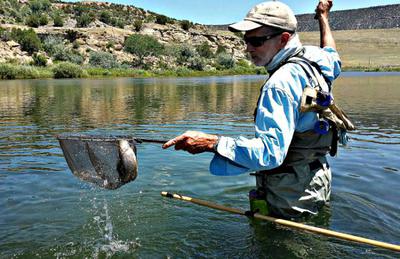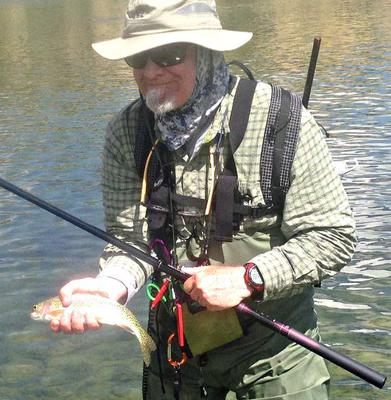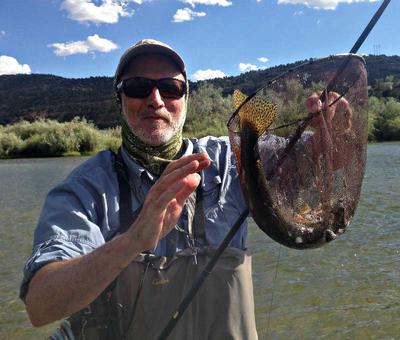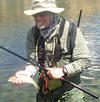Big fish, little flies on the San Juan
by Alan Luecke
(Kansas City, MO)
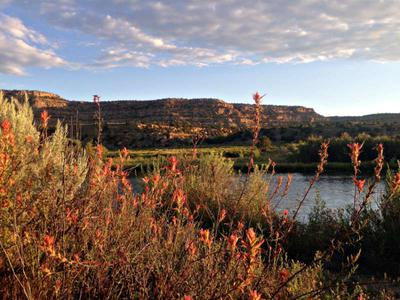
The San Juan River
Earlier this month I was fortunate to spend a week in northern New Mexico fishing with my friend Vern B from Dallas. We started on the San Juan river in the Four Corners area. It is famous, and rightly so, for having lots of big trout. It's also a challenging and unique fishing environment. When people refer to the San Juan they are referring to a 3.75 mile stretch of tailwater below the Navajo Dam, which was built in the late 50's.
From the beginning this stretch of water has been catch and release and until very recently has only been stocked with small fish. The water is cold (40 degrees) but rich with bugs year round. These factors have combined to produce lots of big fish which have plenty to eat and have probably all been caught multiple times. They're a tough sell.
Wade fishing is primarily in the first 3/4 mile below the dam. This is a large area split between large flats-like pools and a series of braided riffles and pools running through small islands. These drain by way of two rapids into the famous Texas Hole which is deep, full of fish and surrounded by fishermen, the waders on one side and the drift boats every where else. From there on down the San Juan is mostly float trip fishing.
During the day it's all about matching the hatch and the hatch is small--22-26's and 6X tippet or smaller, usually with a two fly rig. The fishing is defined by this small light tackle. Regardless of rod type the challenge is to detect the strike and then not pull the fly out of the trout's mouth. The two of us fished all day with a guide and lost one fly, to a rock.
Our guide was Andy Kim, who has been guiding on the San Juan and other western rivers for over 25 years. This is his third year of also guiding tenkara. He grew up with fixed line fishing in Korea and has an amazing understanding what it takes to hook and land a fish regardless of the tools being used.
We were both using Diawa Kiyose rods. Vern had a 53M and I had all three of mine; 33SF, 43MF and 53M. I'm a huge fan of these extremely capable all around rods. Being San Juan newbies all we knew to expect were big fish and open water. Given that, these rods were the perfect choice. They did fine and certainly had more capability than we did. Over the course of two days I caught fish with all three rods in a variety of waters. In the process I used a heavy level line, a light level line, a PVC floating line, an all tippet zero tension rig and, since I got back, a furled line. The 53M, in particular, cast them all without complaint. But wait, there's more.
As we were getting set up and in place with Andy Kim that first morning I was extolling the virtues the Kiyoses--lots of reach, a soft tip for casting and then plenty of backbone for fighting. Andy immediately said, "No, no stiff is bad. Everything must be soft, very soft, soft is better." (Yes, Chris we are having a moment of SP / Zero Tension synergy). To fish the San Juan is to fish tiny flies with very little holding power. Every part of the technique is about minimal force and subtle movement. All day I missed fish from too aggressive hook sets. I knew it and Andy reminded me, nicely, but my hand wouldn't listen to my brain. There is no horsing with a 26 midge. The fish is led and guided. If it jumps drop the tension so it has nothing to shake against. I now think the best San Juan tenkara setup would be a long, soft rod that can handle 6x tippet. Anything more is overkill.
We were fishing in two main styles. Classic drifts in a current with the line off the water and shallow water sight fishing with a floating yarn sighter. The fly set up was one or two small shot on the tippet 8 to 10 inches below the line with a small midge a foot below that. A second midge was tied on another foot below with the dropper tied through the eye of the first fly. That's right, two pieces of 6X through the eye of a 26. I watched Andy do it all day long. The next day I put mine around the hook bend.
When sight fishing for a trout holding in shallow water and slow current we would cast across and in front of the fish and then bring the line in and then over the fish (while compensating for parallax, Andy's serious about this stuff). You cannot feel the take and you can't see the fly. If the fish moves, if its mouth moves, if its gills move set the hook--gently.
All this subtle complexity was a lot to absorb, but I feel like I'm much better prepared for tailwater fishing wherever I might go. A bit of respite could be had in the evenings. After the hatch was over and the sun got low the fish became less picky and more like I'm used to. On two different days I caught fish late casting down and across a rapids with "normal" flies - Utah Killer Bug and a big Killer Bugger.
The San Juan was a unique fishing experience in one of the most beautiful places I've ever been. It's been a rainy summer, even the tops of the desert hills were light green. Incredible.
Return to Your Tenkara Stories.
“The bitterness of poor quality remains long after the sweetness of low price is forgotten” - Benjamin Franklin
"Be sure in casting, that your fly fall first into the water, for if the line fall first, it scares or frightens the fish..." -
Col. Robert Venables 1662
As age slows my pace, I will become more like the heron.
Warning:
The hooks are sharp.
The coffee's hot.
The fish are slippery when wet.
Beware of the Dogma
Currently processing orders that were received Mar 8.
